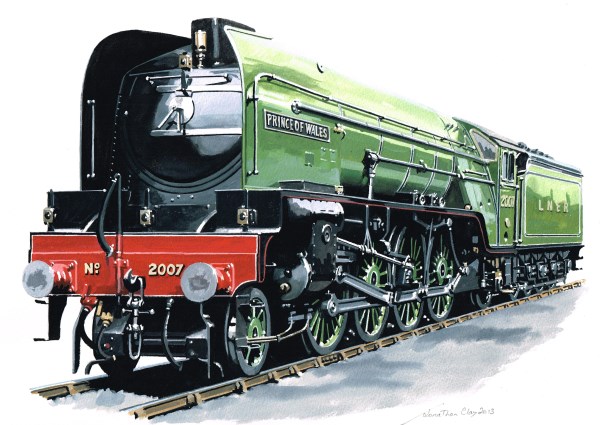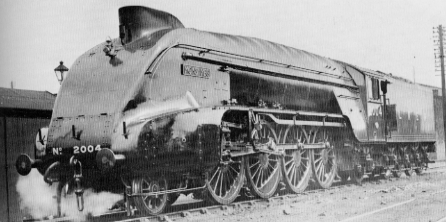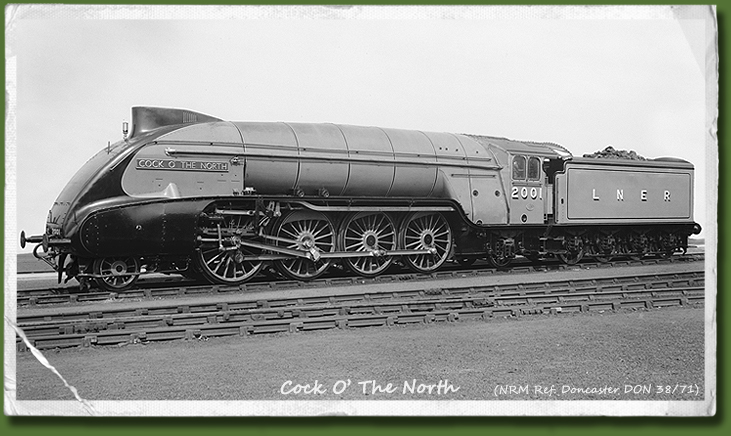Meanwhile, across the pond…this is a P2 Mikado - 3 cylinder if I understand correctly. The next in line - 2007 Prince of Wales is under construction.


Meanwhile, across the pond…this is a P2 Mikado - 3 cylinder if I understand correctly. The next in line - 2007 Prince of Wales is under construction.


Wow, that thing was gorgeous! Leave it to the Brits to take a workhorse like a Mikado and make it look like a racehorse!
They need to do her in full A4-like streamliner casing.
Buy the English magazine called naturally, The Railway Magazine. There’s always info about it. After the knowledge was put together to build the Tornado a few short years ago, the plan is to keep on building new steam. The PoWs frame is almost complete and the wheels have been delivered. There’s others under construction, too. Those limeys don’t screw around!
I wonder how they manage the fundraising? Maybe we should pay 'em to come over here and show us how it’s done?
Or maybe it’s the British people G.A.S. a bit more than Americans do about their steam heritage? After all, next to penicillin and parliamentary democracy Britain’s greatest gift to the world was the steam locomotive.
I disagree, it looked great the way it was. Why mess with perfection?
Firelock, while the first two looked like the images above they were rebuilt with A4-like streamlining. The later 4 of the class had A4-like streamlining from the builder.
http://www.lner.info/locos/P/p2.php
It’s kind of a moot point because I have learned that another group is trying to build another P2 with that streamlining.
Why build one when you can build two?
Doncaster P2 Locomotive Trust
http://www.cockothenorth.co.uk/mission_statement.html
https://www.facebook.com/Doncaster-P2-Locomotive-Trust-Cock-O-The-North-193996747368324/
You’ve got to love the British enthusiasm!
These locomotives apparently had the most tractive force of any UK locomotive, even more than the 9F 2-10-0.
P2 - 43,462 TE on 20 Long Ton Axle Load
9F - 39,667 TE on 15.5 Long Ton Axle Load
Here is the stream-lined version:




Honestly, I really don’t care for that A4 streamlining, the older exterior styling of the locomotive strikes me as a lot more businesslike, if you see what I mean.
I just looked at the “Cock O’ The North” website. Man, if they’ve got Brian Blessed on their side anything’s possible! Ever seen Kenneth Branagh’s “Henry The Fifth?” Mr. Blessed was in it, and he was BORN to wear armor!
The other project (same as A1 Trust people).
It is pretty amazing that while the P2s were apparently the most powerful steam locomotives in the UK with about 43,000 lbs tractive effort, the SP and UP each had Pacifics that basically had equivalent tractive effort to the LNER P2.
To finance it, the Brits have what they call a Covenator scheme where you subscibe a certain amount of money per week to go towards it. Like they say, a P2 for the price of a pint a week, there’s www.p2steam.com email at enquiries@p2steam.com There’s government grants given via a historic lottery as well.
I’m surprised that has not been tried here in the U.S. by a group of steam enthusiasts using a subscription or a campaign on a website like Kickstarter. Go to any railroad museum and you’ll notice that the steam locomotives are always the most popular, even if they are static.
They have. The PRR T1 Trust (among others) heavily promotes the idea of regular monthly contributions. In fact, they say this is how the most money can be raised the fastest, everyone contributing ten or fifteen doallars a month. Most organizations have a “make this a regular mothly contribution” option when donating on their website.
If the SP or UP had to fit a locomotive into a height of 13 feet and a width of about 9 feet (so a foot narrower and nearly two feet lower, on the same gauge), they would have probably ended up with locomotives of lower tractive effort too, since the diameter of the cylinders is one of the major figures in calculating tractive effort and the maximum cylinder size is limited by the overall width. The P2 had 74" driving wheels, which kept the tractive effort down, too. But being a three cylinder locomotive it had a reasonable horsepower for its small size.
M636C
Indeed. Not a criticism of the designers in the UK, just an observation about how much smaller in size UK and continental steam is compared to here in North America. I have been to the National Railroad Museum several times and the Dwight D. Eisenhower is very compact compared to the other steam exhibits. What they have been able to accomplish in the UK is very, very impressive! And it will be interesting to hear what they find out about the P2 in terms of performance - they may prove that their rebuilding in the early 1940s was perhaps not necessary. With Tornado and the Prince of Wales, they are doing a steam-powered version of Jurrasic Park, bringing extinct beasts back to life! Good stuff!
I believe the American Steam Railroad with the Fire Up 2100 project has such a monthly donation of $21.00 for 12 months to fund the Reading T-1 2100 restoration.
Enthusiasm for English Steam Power - this can be seen in America in the Western United States. Union Pacific with the commitment to a long term corporate steam program featuring reconstruction of its Cheyenne locomotive facility and projected operation of UP 4-8-8-4, UP 4-6-6-4 and UP 4-8-4 class locomotives.
Elsewhere especially in Colorado much of the Denver & Rio Grande Western steam locomotive roster of 2-8-2 mikado locomotives are in operation - I believe about ten operational engines are running on their original main lines of the Durango Silverton Railroad and Cumbries Toltec Senic Railroad. This is remarkable and is happening no where else in the USA.
Another Colorado phenomenon is the literal circle of track at Golden Colorado at the Colorado Railroad Museum. Here engines re-restored to operation with a full roundhouse crew just to run on a small circle of track around the musuem - a la like a huge toy train layout. Yes, the ultra sounding of the boilers, the repair of running gear - the re-laging of the boilers - the complete restoration of locomotives - just to go around a large circle of track the size of a football field. Go figure!
Also in Nevada, the Nevada State Government funding with a Federal Congressional grant of $10 million - thanks Senator Harry Reid - Democrat from Nevada - for the re tracking of the original mainline of the Virgina And Truckee Railroad with operation of trains using an assorted collection of orphan steam locomotives gathered from everywhere standing in for the original Virginia Truckee locomotives located primarily in different California museums.
Thats right - the State of Nevada is doing the reclamation of the original railroad grade - the survey of land including clearing of tunnels. The purchase of massive amounts of ties, spikes, rail joiners, bolts, and rails. The assembly of a competent crew and the relaying of the main line track including functional stations
Let’s also remember that the permissible axle load on the ‘permanent way’ was lower (and yes, there was a slightly higher load allowed for the ‘better balance’ of multiple-cylinder locomotives on at least some British railways). That means that the effective factor of adhesion would have to be lower, although perhaps not as dramatically lower as, say, the Golsdorf 2-6-4s (which still awe me for what they can do within strict limitations!) Peter will have specific numbers and contexts for this.
Even with all that, I believe one of the limitations on P2 development was that they were too powerful for the ‘available trains’ on the anticipated routes… this was a platform limitation, in part imposed by very heavy traffic across platform ends that made ‘sticking out’ even by an additional car length or so impossible.
On the flip side – I suspect the much lower frontal area imposed by the British loading gauge was a substantial factor in Mallard’s ability to get to 125 mph… there was a similar thing a few years ago when one of the truck magazines wanted to build a 200 mph diesel truck, and used one of the small pickups for the body…
Note the different valve gears on the streamlined version.